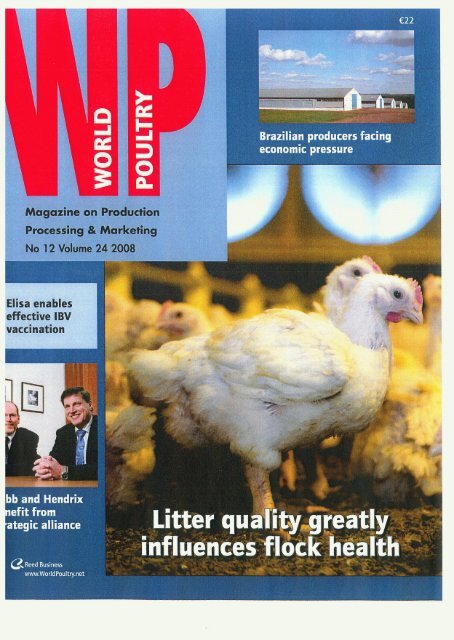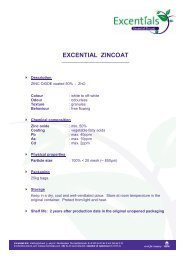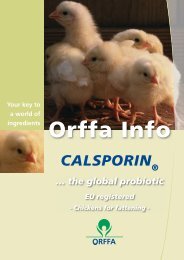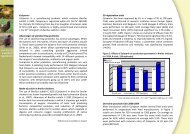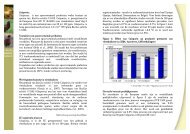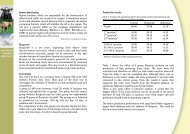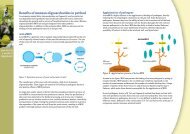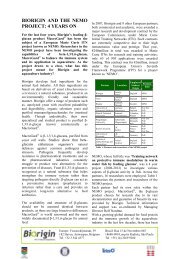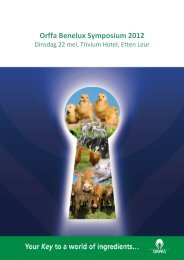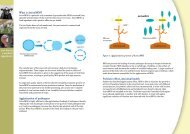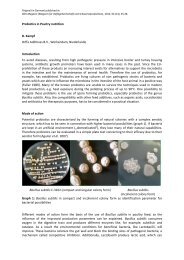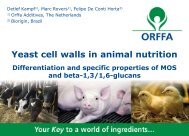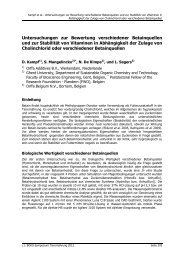AmmoMIN - Orffa
AmmoMIN - Orffa
AmmoMIN - Orffa
You also want an ePaper? Increase the reach of your titles
YUMPU automatically turns print PDFs into web optimized ePapers that Google loves.
IEIJsa ena~les<br />
~effe~tive. 'I BV<br />
lvaçmnatlon<br />
I~
Clay minerals to fight<br />
footpad lesions<br />
Footpad lesions in poultry are an indication of animal welfare<br />
standards. Footpad burns of ten indicate that the animals are<br />
not properly housed and fed. Here we look at how day minerals<br />
in the diet can help prevent these painful foot conditions.<br />
By Arno van der Aa, <strong>Orffa</strong> Additives, the Netherlands<br />
T<br />
he implementation of welfare<br />
measurements for brailers in<br />
recently approveellegislation<br />
has once again put the importance of<br />
prevention of footpaellesions in a new<br />
perspective. In June 2007, EU Directive<br />
2007-43-EC became effective anel<br />
implementation is elue on 30 June, 2010.<br />
Dming the long negotiations the up take<br />
of footpacllesions has been in anel out of<br />
this elirective. Finally it was elecielecl not to<br />
inclucle them as an effective parameter.<br />
However, it was noteel th at at the<br />
evaluation of this elirective in 2012, this<br />
parameter woulel be cliscusseel again.<br />
Importante of the issue<br />
Concmrently, the eliscussion also<br />
contimies on a nationallevel. In the<br />
Netherlancls, for example, footpael<br />
lesions we re still plannecl to be taken<br />
up by the national implementation of<br />
the EU Directive 2007-43-EC. This woulel<br />
mean that the incielence of footpael<br />
lesions woulel become a tooI to elefine<br />
the elensity of birels a poultry farmer<br />
is alloweel to keep, which has a elirect<br />
influence on the economical results.<br />
Just before governmental approval in<br />
July 2008, footpaellesions were (again)<br />
left out of the Dutch regulation. But,<br />
the government agreeel with the poultry<br />
inelustry to investigate possibilities for<br />
monitoring anel aeljusting footpaellesions.<br />
This again inelicates the significance of<br />
this problem, but also the elifficulty for<br />
governments to effectively incluele this<br />
parameter in legislation. In some countlies<br />
footpaellesions have alreaely hael a elirect<br />
effect on fanners' income. Sweelen alreaely<br />
starteel in 1994 with the "brailel' foot<br />
t '" ~<br />
Table 1 . Experimental .<br />
setup.<br />
Treatment Additive Starter Grower Finisher<br />
1 Control<br />
2 Clinoptilolite 0.5% 1.0% 1.5%<br />
A negative con trol group against a treatment with Clinoptilolite<br />
(AmmofVllN, <strong>Orffa</strong> Additives) added to the diet. The procental<br />
addition of Clinoptilolite is a dilution of the diet.<br />
1;:<br />
.<br />
.<br />
.<br />
health programme". In Denmark footpacl<br />
lesions are measurecl in the slaughterhouse<br />
anel farmers are put uncler veterinarian<br />
supervision anel given penalties when<br />
incielence anel severity of footpacllesions<br />
are too high. It is very likely that more<br />
countries will soon follow this kincl of<br />
practice, or that retail and/or NGOs<br />
become driving forces to fultil consumers'<br />
clemanels. For the benefit of the poultry<br />
inelustry, a pro-active approach seems<br />
aelvisable.<br />
Multiple fadors<br />
Footpad lesions are a multifactorial<br />
disorder anel are affecteel by internal<br />
anel external factors. Internal factors of<br />
influence can be categorised as sex, breeel,<br />
age, pressme, elaily growth and animal<br />
health. External factors incluele water<br />
supply, litter type, litter height, top<br />
elressing of litter, climate, season, light,<br />
bird elensity, faeces elistribution anel, last<br />
but certainly not least, feed composition<br />
(Velelkamp 2007). Within this article, the<br />
effect of feed measurements, but more<br />
particularly the use of clinoptilolite<br />
(clay mineraIs), will be discusseel.<br />
Feed measurements<br />
There are several ways to manage litter<br />
quality anel footpaellesions with feeel<br />
strategies. The levels of sodium anel<br />
potassium in the feed may affect water<br />
up take and thereby leael to wet litter<br />
prablems. Some feed ingreelients, like<br />
soy and tapioca, have high potassium<br />
levels anel thereby also high levels<br />
of certain feed ingredients th at may<br />
affect litter quality. High levels of<br />
cruele protein are also known to have<br />
a negative effect on litter quality.<br />
High pratein levels cause high levels of<br />
mic acid formeel in the liver anel excreted<br />
by kidneys, thereby stimulating water<br />
up take anel wet droppings. To prevent<br />
footpad lesions, inclusion levels ofbiotin<br />
may be of importance. Biotin impraves<br />
the formation and elevelopment of the<br />
upper skin. Earlier reports have shown<br />
that biotin eleficiencies increase footpael<br />
lesions (Mayne, 2005).<br />
WORLD POULTRY.VoI.24 No 12. 2008 ~p www.woridPoultry.net15<br />
v'~_<br />
Importante of litter quality<br />
Litter quality is an il11.portant parameter<br />
regareling the incielence and severity<br />
of footpad lesions. Moistme content<br />
is important, since wet litter is known<br />
to influence the OCCUlTence of footpad<br />
lesions in broilers anel turkeys (Mayne,<br />
2005). The combination ofwet litter<br />
combineel with nitragen components<br />
like ammonia is irritating for footpads.<br />
The combination of wet litter and high<br />
ammonia can affect the footpad, which<br />
results in colourisation of the skin,<br />
and ultimately ulcerations.<br />
Damageel footpaels give free way for<br />
nmgi or bacteria to cause seconelary<br />
infections, which may even leael to<br />
conelemnations of the car-cass (Ekstranel<br />
et al, 1997). Brailers affecteel by footpad<br />
lesions will experience pain anel therefore<br />
redllCed mobility, thereby leacling to<br />
lower feed intake anel grovvth.<br />
.<br />
Clay minerals and litter quality<br />
Clinoptilolites are specially selecteel clay<br />
minerals lmown for their typical structme,<br />
which enables the clay mineral to bind<br />
ammonia (Suchy et al, 2006). As a re sult
(%)<br />
6~<br />
Feed intake (0-35d) gr 3457 3611<br />
25,9::. Corrected FCR (0-35d) 1.621 1.629<br />
:24 !sll[..~.-.=........'.-.-...~.:.'.:..'.'-.'.-.'.:.-::::----::-:=:~<br />
I<br />
usage of protein sources.<br />
Litter score<br />
Day 7<br />
1<br />
1<br />
Using a dilution<br />
strategy inc1ueling c1inoptilolite can be<br />
_<br />
, I<br />
2~;<br />
__ __<br />
[::Ù,i::-:::<br />
~31-.-<br />
22 51.-<br />
22<br />
control<br />
---24~6----<br />
gut health is improved, since ammonia<br />
is toxic to the gut wall. As an additional<br />
effect, a reeluction of footpad lesions<br />
may be expecteel because ammonia<br />
bOlmd to c1inoptilolite causes less<br />
irritation to the footpads.<br />
In 2001, the binding of ammonia by<br />
clinoptilolite was testeel in piglets by<br />
the University of Ghent in Belgium.<br />
They founel that 32% of total ammonia<br />
was bounel in faeces of piglets fed diets<br />
that containeel clinoptilolite, compared<br />
to only 1% with bounded ammonia in<br />
the con trol treatment. ResuIts from<br />
several trials have shown th at inclusion<br />
of clinoptilolite in the diet reduces<br />
water excretion and thus improves litter<br />
quality. As a resuIt of ammonia bineling<br />
in the gut, technical performance is<br />
also improved. In the following sections<br />
different trials are discussecl.<br />
'Figùre'2. Èffect of.c1inoptilolitë on:lesioÍ1severity,'<br />
"<br />
; -<br />
Germaíí field.trial :;;;'<br />
2005<br />
',,,.. '".~<br />
~'~~< ~
I ,~~ / \ \<br />
/' -----


